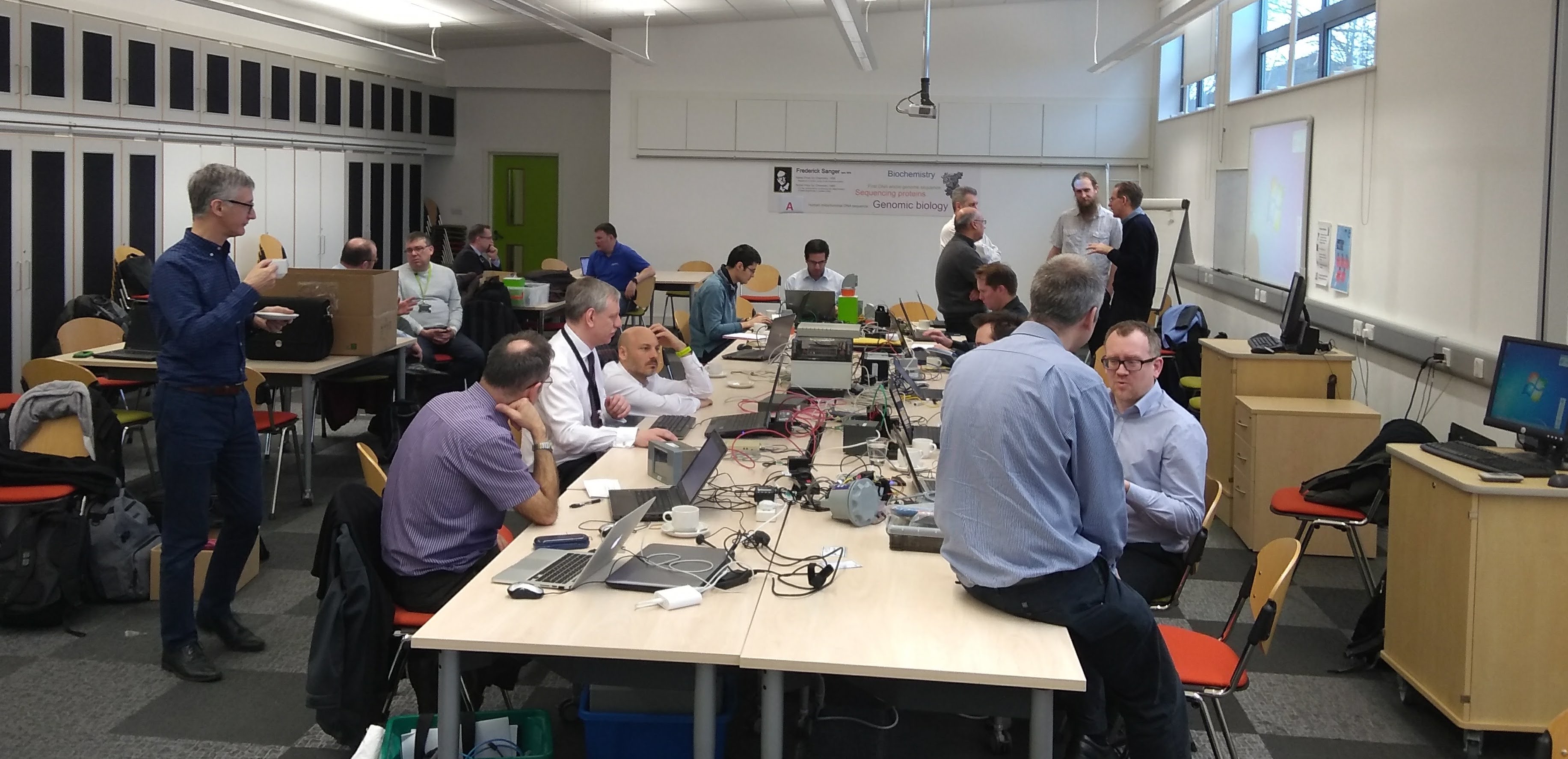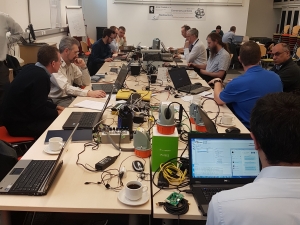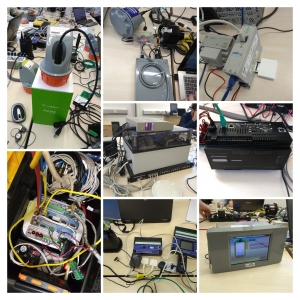Introduction
After the success of the last WITS-DNP3 protocol plugfest in May 2017, a further plugfest was arranged for Wednesday January 17th 2018. Jerry Trowbridge of Northumbrian Water kindly booked the excellent Sjovoll Centre in Pity Me, close to Durham and the Northumbrian Water offices for both the plugfest and user meeting (which was held the day after). On the day, two large meeting rooms were joined together to provide a huge space in which all the WITS Vendors and users could meet and set up their equipment for the plugfest.
As requested by users at a previous user meeting and by vendors at the last plugfest, the plugfest and user meeting were arranged on consecutive days, allowing users to attend both meetings easily. Those users who could make it, turned up on Wednesday 17th January for the Plugfest and stayed on till the Thursday for the user meeting. Users attending the plugfest included Anglian Water, Northern Ireland Water, Northumbrian Water and United Utilities. In all, over 30 people (users and vendors) attended the plugfest day.
The day
Having a plugfest every six months managed to place this plugfest in January and as is often the way in England, the weather managed to provide some challenges in getting to Durham. Severe snow and road conditions prevented the main Xylem contingent from making the Plugfest (travelling out of Scotland) and even though the night before saw a 4 inch snowfall in Durham, everyone else was eventually able to get to the venue.
Our day started at 8:00am when Master Station and Field Device vendors started arriving at the Sjovoll Centre and setting up their equipment. As you can see from the photo below, we had a large room with a huge island of tables in the middle.
As per the previous plugfest we ran a single internal IP network, to which all the equipment connected, and a good old fashioned white board on which we carved out static IP addresses so everyone could talk without problems. For our two mobile connected devices, the Cello from Technolog and the Point Orange from Metasphere, we used a fixed IP SIM in a mobile router connected onto the fixed IP network. This time we also had a telephone exchange available which allowed us to test PSTN from various Field Devices.
What happened
The day was split up (informally) as follows:
- A connection session first thing in the morning to prove that the devices could be connected to the Master Stations.
- For the remainder of the day Field Device vendors tested their devices against the Master Stations.
The testing performed on the day varied for each vendor but largely fell into one of the following categories:
- Testing of a vendor’s latest firmware against one or both Master Stations.
- Re-testing of firmware where specific problems had been noted in the past to ensure those problems were fixed.
- Testing of a vendor’s device with the Master Station it is not normally deployed against.
The last category of testing above is one made particularly easy during the plugfest as all licensing restrictions for both Master Stations are removed during the day of the plugfest.
Who came and what were they testing
The following table lists the FD (Field Device) vendors who attended the day. As well as these FD vendors, both Master Station vendors also attended: Servelec Technologies with Scope (version 4.5, trunk revision 59564), capable of supporting up to WITS 1.2 and Schneider Electric with ClearSCADA 2017 6.78.6325, capable of supporting up to WITS 1.3.
| Vendor | Device | Device Version | Highest WITS Version |
| Brodersen | RTU32 | 1.60.2.5 Driver version 1.1.60.1007 |
1.3 |
| Metasphere | Point Orange | V9.0c0019 Beta | 1.1 |
| Multitrode (Xylem) | Multismart Gen 2 | 3.3.8 | 1.3 |
| Pulsar | Ultimate | 2.0.3 RTU Version | 1.1 |
| Servelec Technologies | S2000 S2000 Micro S2000 Nano |
5.1.4 | 1.3 |
| Softing | WITS Gateway | 1.2 | 1.3 |
| Technolog | Cello 4C | Logger 4.08, WITS 1.1.49 | 1.1 |
| Technolog | Cello 4S | Logger 4.41, WITS 1.1.61 | 1.1 |
The following picture shows the various devices present at the day and gives an idea of the rats nest of wires that tends to exist during the day, but amazingly rarely seems to feature as one of the problems.
The WITS Chair, Simon Harrison was present, together with various consultants who attended to assist during the day and lend their knowledge to the process; they were Mark Davison and Neil Tubman from Terzo Digital and John D Hall who, as an honorary member of the WITS PSA, was acting as an independent.
A WITS IoT Presentation
In the early afternoon, Steve Beadle of Schneider Electric presented a slide set about WITS-IoT, what it was and the progress that has been made by the WITS-IoT team in developing the new protocol. Steve also demonstrated what a WITS-IoT driver might look like in ClearSCADA using a prototype version he has been working on. Steve, Stuart Combellack and Mark Davison of the WITS-IoT core team were then on hand to answer questions about what WITS-IoT would mean for vendors and how they could start thinking about incorporating the protocol into their products.
The Outcome
During the day, several interesting issues were raised. However, unlike the last plugfest where these issues resulted in nine new tickets being raised in the WITS JIRA, no new issues were raised in JIRA this time. Most of the issues raised were specifically for the vendors and not for the WITS-DNP3 Protocol itself, those not fixed on the day were taken away to be fixed slow time and no doubt tested again at the next plugfest.
As for the last plugfest, one of the main advantages of the day is to have the actual staff involved in development of the WITS products from each vendor present in the same room at the same time. This means that failures in operation can be quickly found, analysed and sometimes even fixed in the same session. This is something that would be much slower and more difficult outside the plugfest environment.
After the day, we sent out a small mail survey to see what attendees had made of the Plugfest once they had collected their thoughts. The main points coming back from that survey were:
- ‘How useful was the day’ was rated on average as 4.25 out of 5, slightly down on the 4.5 of the last plugfest but still high.
- Access to both master stations, and experts, was seen by many as a benefit of the day.
- Most people thought another in 6-12 months would be good.
- In asking for a single word to describe the day we only received positive words such as ‘busy’, ‘entertaining’, ‘wintry’, ‘constructive’ and ‘useful’.
Vendors liked the fact that some users attended the plugfest and we will try and encourage more for the next one.
What comes next?
The WITS PSAC is now trying to organise the next plugfest for summer/late summer at Thames Water. This will also be accompanied by a user meeting at that time in an attempt to ensure as many users as possible have a chance to attend the plugfest as well. Hopefully weather will provide no issue at the next meeting.
Although requiring further discussion before then, it is hoped that a standard small set of tests can be selected to be run at each plugfest to show that vendors firmware is still WITS compliant. We also hope to start recording attendance at the plugfests and the success of running those tests in the device catalogue. This will aid users in gaining confidence that a Field Device is likely to work with their Master Station. To add even more structure to the day, we may also consider adding specific test sets to demonstrate correct operation of later features of the WITS protocol. I am sure there will be more published on all this between now and the next WITS plugfest.
If you have ever wondered how we tidy up all those wires and equipment, then wonder no more! The above gives a quick time lapse view of nearly the whole process.
If you have any questions about the Plugfest or would like to be involved in any future Plugfests we organise, then please contact the secretary through enquiries@witsprotocol.org.
Mark Davison, Terzo Digital, February 2018





[…] which was hosted by Jerry Trowbridge of Northumbrian Water; you can read more on that plugfest here. In a similar way to the January meeting, a WITS User Meeting was planned for Wednesday 10th […]